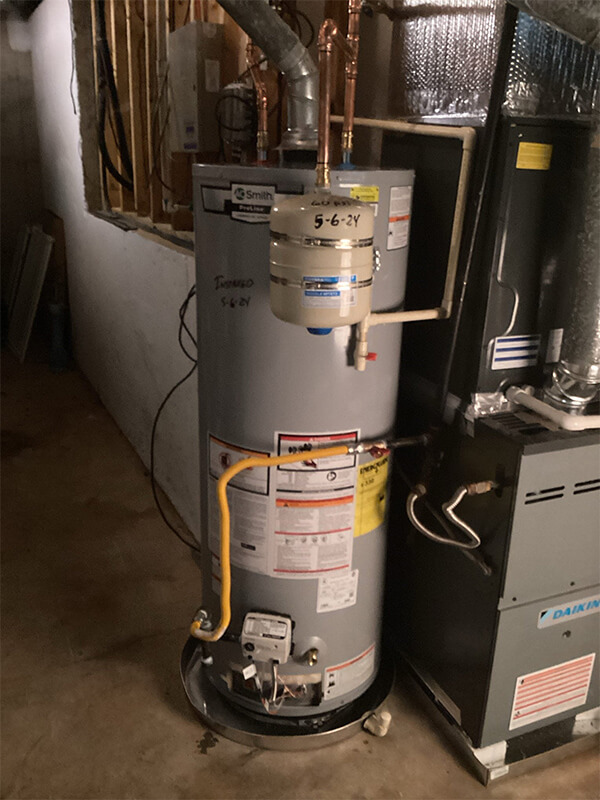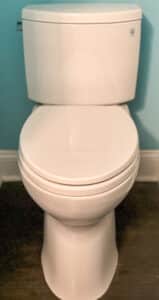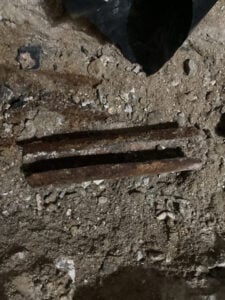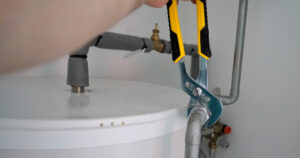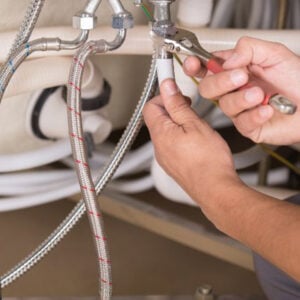
Gas Water Heater – Essential Guide
Gas water heaters are used in many American households and are known for their efficiency and capability to provide a consistent supply of hot water. As one of the most common types of water heaters, gas models operate using natural gas or propane and are favored for their rapid heating ability and cost-effectiveness over time. If you’re considering replacing your current water heater or switching from an electric model, learning about gas water heaters will demonstrate their potential benefits for your home’s energy efficiency and cost management. For those interested in electric models, refer to our comprehensive guide on Electric Water Heaters to compare the options. Did you know that modern gas water heaters can operate with over 90% efficiency, significantly reducing energy waste? Many modern gas water heaters come equipped with advanced technology, such as modulating burners and electronic ignition systems, which enhance safety and optimize fuel usage to adjust to your specific hot water needs in real-time.
Benefits of Gas Water Heaters
Cost-Effectiveness
Gas water heaters stand out for their energy efficiency, often resulting in lower operational costs over their lifespan. The natural gas typically used in these heaters generally costs less than electricity per unit of heat produced, translating to noticeable savings on monthly energy bills. Additionally, the efficient transfer of heat in gas systems reduces the amount of energy wasted, maximizing your investment.
Faster Heating
One of the most appreciated advantages of gas water heaters is their capacity to heat water quickly. This rapid heating capability means that hot water is available on demand, reducing wait times and enhancing convenience for household activities that require immediate hot water, such as bathing or washing dishes.
Reliability
Gas water heaters provide a reliable source of hot water even during power outages, making them particularly valuable in areas prone to electrical disruptions. Unlike electric water heaters that rely on the power grid, gas models can continue operating as long as there is a gas supply, ensuring that your home has consistent access to hot water regardless of external power conditions.
Gas Water Heaters Explained
Types of Gas Water Heaters
Gas water heaters come in various types, each designed to fit different needs and preferences:
- Storage Tank Water Heaters: These are the most common type. They consist of an insulated tank where water is heated and stored until needed. Gas burns in a burner under the tank, heating the water above it.
- Tankless Water Heaters: Also known as on-demand water heaters, these units heat water directly without the use of a storage tank. When a hot water tap is turned on, cold water travels through a pipe into the unit where a gas burner heats the water instantly, providing a continuous supply of hot water and saving energy by not having to heat and reheat water in a tank.
- Hybrid Water Heaters: These combine the technology of tank and tankless models. They have a small storage tank to provide an initial supply of hot water quickly, and then switch to on-demand heating to maintain the supply as needed, optimizing energy usage.
How Gas Water Heaters Work
The operation of a gas water heater is straightforward yet efficiently designed. Here’s a simplified breakdown:
Thermostat Control
A thermostat is crucial in monitoring the temperature inside the water tank. When the water’s temperature falls below the predetermined setting, the thermostat signals the gas burner to activate. This automatic control ensures the water remains at a consistent heat level ready for use.
Gas Burner and Heat Exchanger
Positioned at the bottom of the tank in storage models, or integrated into the unit in tankless models, the gas burner ignites upon receiving a signal from the thermostat. For storage tank models, the burner directly heats the water contained in the tank. In contrast, tankless models heat water on-demand as it passes through a heat exchanger, efficiently delivering hot water directly to your taps without storing it.
Exhaust System
The process of burning gas produces combustion gases, which are harmful if allowed to accumulate. These gases are expelled from the home through a flue or exhaust vent. This system not only disposes of dangerous gases but also helps maintain the efficiency of the heating process by ensuring a proper draft for the burner.
Water Supply and Distribution
The design of the water heater allows for the natural process of thermosiphoning where heated water rises to the top of the tank. When a hot water tap is opened, this hot water exits the tank from the top. Simultaneously, cold water is drawn into the bottom of the tank, replacing the hot water that was used, thereby maintaining a full tank ready for heating.
This basic process ensures that your home has hot water when needed while maintaining safety and energy efficiency.
Professional Installation Considerations for Gas Water Heaters
Installing a gas water heater requires precise knowledge of gas systems and water heater technology. Certified professionals have the training to ensure that the installation complies with all safety codes and operational standards. These standards are required for preventing gas leaks and ensuring that the system functions safely and efficiently. A professional installer also understands the importance of correct placement and secure mounting, which helps prevent physical damage to the unit over its lifespan. Keep in mind that many manufacturer’s warranties require professional installation to remain valid.
Ventilation Requirements
The primary purpose of a ventilation system is to remove combustion products generated by the heater to the outside, preventing the accumulation of harmful gases such as carbon monoxide within indoor spaces.
Types of Ventilation Systems:
- Direct Vent Systems: These systems draw air from outside the home for combustion and vent exhaust gases back outside. They are sealed from the indoor environment, which prevents indoor air from being used in combustion and is particularly beneficial in tightly sealed homes.
- Power Vent Systems: Utilizing an electric fan or blower, these systems push exhaust gases through vent pipes and out of the home. This type of system is flexible in terms of installation since it does not require a vertical vent or chimney and can be vented horizontally.
- Atmospheric Vent Systems: The most common and traditionally used, these systems rely on the natural buoyancy of hot gases to rise and exit through a vertical flue or chimney. They require careful installation to ensure that the venting is always rising without any dips where condensation can collect and block the vent.
Installation Considerations:
- Proper Sizing and Design: Ventilation systems must be correctly sized to handle the volume of gases produced by the water heater. Incorrect sizing can lead to inefficient venting and the accumulation of dangerous gases.
- Compliance with Codes: Installation must adhere to local building codes and standards, which may specify the types of materials to be used, the allowable lengths of vent pipes, and the methods for terminating the vent outside the house.
- Regular Maintenance: To maintain their effectiveness, ventilation systems require regular inspections and maintenance to ensure that they are free from blockages, leaks, or corrosion and are performing optimally.
Gas Line Specifications and Safety Checks
The installation of a gas water heater requires meticulous attention to the gas line setup.
Gas Line Installation Specifications:
- Material Selection: Gas lines can be made from various materials, including flexible corrugated stainless steel tubing (CSST), black iron pipes, and copper. Each material has specific usage guidelines and compatibility requirements with different types of gas.
- Proper Sizing: The diameter and length of gas lines must be calculated based on the BTU (British Thermal Unit) requirements of the water heater and any other appliances connected to the same line. This ensures adequate gas flow and efficient operation.
- Connection Integrity: All connections must be securely tightened and tested for leaks. Techniques such as the application of soapy water to connection points can help identify any escaping gas, which will produce bubbles at the site of a leak.
Safety Checks:
- Leak Testing: After installation before the first use, and periodically thereafter, gas lines should be checked for leaks using proper testing equipment. This is crucial to prevent gas leaks that could lead to fire hazards or health risks.
- Ventilation Check: As part of the safety inspection, checking the ventilation system around the gas lines and appliances ensures that any leaked gas does not accumulate.
- System Pressure Tests: Conducting pressure tests on the gas system ensures that the lines can handle the operational pressure. This test can help identify weak spots that might not yet be leaking but could fail under normal operating conditions.
Regulatory Compliance:
- Code Adherence: Installations must comply with national and local codes that dictate specifications for gas line installations. These codes help ensure safety and are updated regularly to reflect the latest safety standards.
- Certification Requirements: Only certified professionals should perform gas line installations and checks. These professionals are trained to understand and implement code requirements and handle the materials safely.
Maintenance and Safety
Proper maintenance and safety measures are crucial for the longevity and safe operation of gas water heaters. This section provides guidelines on routine checks and maintenance tasks, outlines key safety measures, and offers troubleshooting tips for common issues, based on advice from experienced technicians.
Frequently Asked Questions (FAQs)
What’s the lifespan of a gas water heater?
Gas water heaters typically have a lifespan of 8 to 12 years with proper maintenance. However, factors such as water quality, usage patterns, and maintenance frequency can influence longevity. Regular maintenance, including flushing the tank to remove sediment buildup and inspecting components for wear, can extend the lifespan of your gas water heater.
How often should maintenance be performed on a gas water heater?
Maintenance should be performed annually to ensure optimal performance and longevity. Tasks include flushing the tank to remove sediment, inspecting the anode rod for corrosion, checking for gas leaks, and testing the pressure relief valve. Regular maintenance helps prevent issues such as reduced efficiency, leaks, and premature failure.
What are the signs of a failing gas water heater?
Signs of a failing gas water heater include inadequate hot water, fluctuating water temperatures, unusual noises (such as rumbling or popping), foul odors, water leaks around the unit, and visible rust or corrosion. If you notice any of these signs, it’s essential to have your water heater inspected by a qualified professional to determine the cause and address any necessary repairs or replacements promptly.
Is it worth switching from electric to gas?
Switching from electric to gas can offer several benefits, including lower operating costs, faster water heating, and improved energy efficiency. Gas water heaters typically have lower annual operating expenses compared to electric models, especially in regions where natural gas is inexpensive. However, it’s essential to consider the upfront costs of installation, including any necessary gas line extensions or modifications. Additionally, assess the availability of natural gas in your area and factor in any potential rebates or incentives for installing energy-efficient appliances.
For more information on gas water heaters, maintenance tips, and installation considerations, explore our comprehensive Water Heater Buying Guide.

